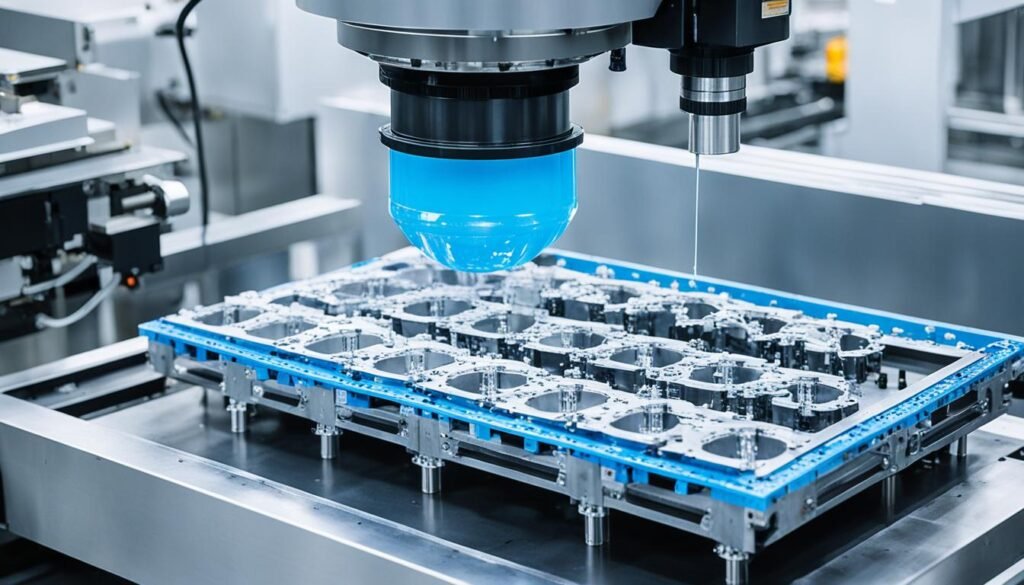
Did you know that the THY Precision Injection Molding Optical Lenses process step by step changes the game in making optical lenses? THY Precision, a top name in precision polymer optics, shows how this new way is cheaper than old methods. Get ready to see the big benefits Injection Molding Optical Lenses offers.
In today’s world, where being quick and innovative matters, plastic injection moulding is a big deal in making optical lenses. With Injection Molding Optical Lenses cycle, THY Precision makes high-quality, affordable optical solutions. But why is this process so good, and why should you think about it for your next project?
Imagine if the mold design, melt delivery system, clamping unit, injection unit, cooling system, and part ejection changed how you make optical lenses. Get ready to learn more about Injection Molding Optical Lenses. We’ll show you how injection molding optical lenses are cheaper than traditional methods for optical lens manufacturing.
Key Takeaways
- Learn about the Injection Molding Optical Lenses process step by step and its benefits over old ways.
- See how injection molding is cheaper for making optical lenses.
- Find out how THY Precision uses plastic injection moulding for new and efficient optical solutions.
- Understand the parts of the Injection Molding Optical Lenses cycle and their role in the process.
- Learn about the uses and design limits of injection molded optics.
Introduction to Injection Molding Optical Lenses Optical Lenses
Injection Molding Optical Lenses is a key method for making optical lenses. It’s both versatile and cost-effective. When working with injection moulding process step by step, knowing the materials used in plastic injection molding is key. These materials include acrylic, styrene, polycarbonate, cyclic-olefin polymers (COPs), and cyclic-olefin copolymers (COCs).
These materials are great for making optical lenses because they have special features. They need to handle heat, stay clear, and not absorb water. They also need to be light, have the right refraction, and not change shape much when heated. Designers must know these things to pick the best materials for Injection Molding Optical Lenses cycle of optical lenses.
| Material | Properties |
|---|---|
| Acrylic | High transparency, good scratch resistance, low cost |
| Styrene | Excellent optical clarity, low cost, good impact resistance |
| Polycarbonate | High impact resistance, good thermal stability, moderate cost |
| COPs and COCs | Superior optical properties, low birefringence, moderate cost |
Knowing the special features of these materials helps designers use injection moulding process step by step to make new and affordable optical solutions.
“Injection Molding Optical Lenses is a game-changer in the world of optical lens manufacturing, allowing for precise, cost-effective, and scalable production.”
Injection Molding Optical Lenses Process Step by Step: A Comprehensive Overview
At THY Precision, we know how crucial the injection moulding process is for making top-notch optical lenses. This method is great for making copies of complex shapes like spherical, aspheric, and free-form surfaces. It also lets us add special features for mounting. Let’s explore the main steps in this advanced manufacturing method.
The Mold Design
The mold for making polymer optics at THY Precision has three key parts: the cavity details, the optical inserts, and the housing. The cavity details shape the lens and its surface. The optical inserts control the lens’s optical properties. The housing keeps everything in place and aligned during the molding process.
The Molding Machine
The molding machine, or press, is the heart of the injection moulding process at THY Precision. It has a fixed and moving platen, a clamping unit, and an injection unit. The machine melts plastic pellets into a liquid state and fills the mold. As it cools, the plastic takes the shape of the mold, making the final lens.
By understanding the details of the injection moulding process, THY Precision can make high-quality optical lenses that meet our customers’ needs. Our skill in designing molds and using advanced machines shows in every lens we make. We’re dedicated to excellence.

| Step | Description |
|---|---|
| 1. Mold Preparation | The mold is cleaned, heated, and coated with a release agent to help the lens come out easily. |
| 2. Plastic Feeding | Plastic pellets are fed into the machine, melted, and mixed to a uniform state. |
| 3. Injection | The melted plastic is pushed into the mold under high pressure, filling it perfectly. |
| 4. Cooling | The mold cools, letting the plastic harden and take the mold’s shape. |
| 5. Ejection | The finished lens is pushed out of the mold, ending the injection moulding process. |
At THY Precision, we’ve perfected the injection moulding process, making sure every lens is top quality. Our drive for innovation and constant improvement keeps us leading in this field. We deliver the best products to our customers.
Advantages of Injection Molding Optical Lenses Optics
Polymer optics bring big benefits to optical tech, especially when compared to glass. They are much lighter, weighing 2 to 5 times less, making them easy to carry around. They also handle impacts better, which means they last longer and work more reliably in different situations.
Injection molding of optical lenses is a big win for saving money. This method makes complex shapes quickly and affordably. It also lets THY Precision put together optical and mechanical parts in one piece. This cuts down on costs by reducing the need for extra parts and assembly.
- Weight reduction of 2 to 5 times compared to glass
- Enhanced impact resistance for increased durability
- Cost-effective replication of complex shapes through injection molding
- Combining optical and mechanical features to reduce overall system cost
THY Precision’s injection molded optics are a top pick for many uses, from gadgets to medical tools. Thanks to plastic injection moulding, they offer quality optics that are both budget-friendly and cutting-edge.
“The significant cost reduction is often overlooked, as injection molding enables the replication of complex shapes in a cost-effective manner.”
Injection Molding Optical Lenses – Comparison with Traditional Methods
The injection moulding process for making optical lenses is a big step up from old ways. Glass has always been the go-to, but now, polymer-based injection moulding is changing the game. It’s cheaper and brings new ideas to the table.
Cost Considerations in injection moulding process step by step
One big plus of injection moulding for lenses is the big cost cut it offers. It’s fast and uses cheaper materials than glass. This makes it perfect for making lots of lenses.
Recently, the injection moulding process has gotten even better. New tech and better ways of doing things have made it more competitive. Now, it’s a strong choice even for high-end uses that used to be for glass only.
| Metric | Traditional Methods | Injection Moulding |
|---|---|---|
| Raw Material Cost | Higher | Lower |
| Production Speed | Slower | Faster |
| Scalability | Limited | High |
| Cost per Unit | Higher | Lower |
Polymer optics are lighter and cheaper, but they’re not perfect. They don’t bend light as well as glass and can’t handle heat as well. They also expand more when it gets hot and can get damaged easily. But, you can use the best of both worlds by mixing glass and polymer ideas together.
Applications of Injection Molded Optics
The injection molding process step by step has made polymer optics very useful in many areas. These parts are now common in different fields because they are affordable and innovative.
In the biomedical field, they are used in devices for diagnosis and single-use tools. They are a good choice because they are flexible and don’t need the cleaning that glass parts do.
For biometric uses, like in retinal scanners and fingerprint readers, injection molded optics are perfect. They offer the right mix of flexibility, precision, and cost for these important devices.
In consumer electronics, injection molded optics are everywhere. They’re in phone cameras, displays, barcode scanners, and digital cameras. This is because they’re cheap and easy to make in large numbers.
| Application | Benefits of Injection Molded Optics |
|---|---|
| Biomedicine | Design flexibility, low production costs, single-use systems |
| Biometrics | Design versatility, precision, cost-effectiveness |
| Consumer Electronics | Affordability, suitability for mass production |
The use of injection molded optics shows how versatile and cost-effective this method is. As technology gets better, we’ll likely see more of these polymer optics in our lives.
“The versatility of injection molding has allowed polymer optics to become a go-to solution in a variety of industries, from biomedical to consumer electronics.”
Overcoming Design Limitations
At THY Precision, we know that injection moulding process step by step has many benefits. But, it also has some design limits. These include lower refractive indices, narrower temperature ranges, higher thermal expansion, and issues with water absorption and surface damage.
Our team has found ways to beat these challenges. We use a hybrid design that mixes glass and polymer strengths. We also use protective coatings and special inhibitors to stop water absorption and protect the surface.
Our injection moulding process step by step helps us overcome these limits. We offer our clients affordable, high-quality optical solutions. By using polymer optics, we make products that are better than traditional glass ones.

At THY Precision, we aim to push the limits of injection moulding process step by step. Our experts work hard to find solutions that make the most of polymer optics. This gives our clients great performance and value.
“By addressing the design limitations of polymer optics, we can unleash the true power of injection moulding process step by step and provide our clients with innovative, cost-effective solutions that outperform traditional methods.”
We deeply understand the injection moulding process step by step and its challenges. We work with our clients to find what they need. Then, we use the latest in polymer technology and manufacturing to make custom solutions.
| Design Limitation | Overcoming Strategy |
|---|---|
| Lower Refractive Indices | Hybrid Design Combining Glass and Polymer |
| Narrower Operational Temperature Ranges | Protective Coatings |
| Higher Thermal Expansion | Inhibitors to Deter Cross-Linking |
| Susceptibility to Water Absorption and Surface Damage | Harder Surface Coatings |
With our injection moulding process step by step expertise and teamwork with clients, THY Precision can beat the design limits of polymer optics. We offer innovative, affordable solutions that meet the industry’s changing needs.
Conclusion
The injection moulding process has changed how we make optical lenses. It brings benefits like cost savings, lighter products, and more design options. By understanding this process and the special properties of optical polymers, you can improve traditional lens making.
This process is getting better, making injection molded optics more useful in many fields. Working with experts like THY Precision lets you use the latest in optical technology. This keeps you ahead in your market.
Injection moulding has changed the game. It lets companies like THY Precision make lenses that are affordable, light, and can be customized. Exploring injection molded optics shows how important it is to use this process well in your work.



